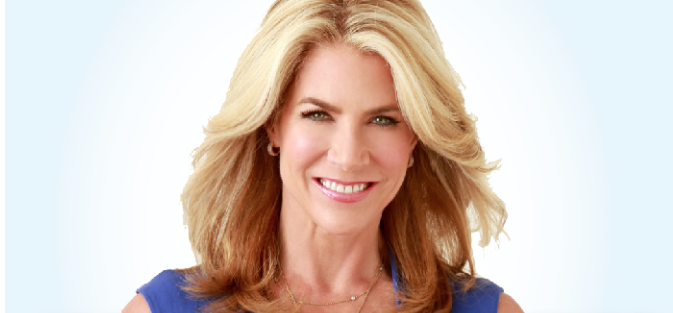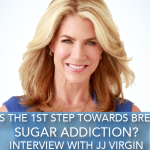Episode 48 | JJ Virgin | Conquer Your Cravings

LISTEN…CLICK PLAY!
Kathy Smith: So, JJ, in your Sugar Impact Diet, you shine a light on sugar and how it presents this direct threat to our health. Tell us why is sugar so evil and, yet, it tastes so good. And more importantly, what impact does it have on our health?
JJ Virgin: Now, how could it be so bad if it tastes so good, right? It just doesn’t seem fair. My goodness. You think back thousands and thousands of years ago, we would occasionally find a beehive or we’d occasionally, in the summer, get a bunch of fruit, but it wasn’t like it was readily available.
So, we’re hard-wired to seek it out so we can scarf it down and survive during the winters, which never happen now. So, what happens when you eat more than you’re supposed to? Which is pretty much everybody because sugar sneaks into places you’d never expect like the marinara sauce and the little salad things that turn your salad into a sundae. It makes you more insulin resistant, leads you to diabetes, makes you store belly fat, raises your risk of heart disease, feeds the worst cancer, ages you, dumps your immune system, feeds the bad bacteria in your gut and the yeast. You look at every major disease out there and if sugar didn’t cause it, it’s at least playing a big role in exacerbating it.
Kathy Smith: It’s interesting too that people don’t actually know–even though we hear over and over again that sugar hides everywhere. I’m surprised. I had a whole group up here in Park City for Sundance and people are staying at my house and people are thinking, “Oh, my gosh. Well, I’m buying oat milk or almond milk,” and still coming and thinking they’re eating a healthy breakfast with a protein shake, were using their almond milk or this oat milk, which had 18 grams of sugar. The other one that was crazy is that a friend–
JJ Virgin: Oh, man!
Kathy Smith: A friend of mine brought these carbonated–it’s like a sparkling water, but they were called blood orange sparkling water. So, it had a great label. It looked great. I turned it over. It had 34 grams of sugar. I looked at the guy. I said, “You know. This is just about as much as a Coke has.
JJ Virgin: It’s soda.
Kathy Smith: Yeah, it’s soda. Tell me, because I know that it’s important to read labels and to keep reminding ourselves to read those labels. But it hides everywhere, right? It’s just about in so many places. What are the biggest culprits?
JJ Virgin: The problem is the labels can mislead you because we’re starting to get smarter now. So, they’ll say things on the front that say, “No sugar added.”
You go, “Oh! This is great.” And what you don’t realize is that they can take something like apple juice concentrate which is just syrup. Ok? It’s just syrup. It’s like high fructose corn syrup. It just came from apples, not corn. And they can put apple juice concentrate on there and say, “No sugar added.”
It’s crazy, but the places that you’ll see it hide the most are in a lot of the–especially the low-fat or light dressings. Because when they take the fat out, they have to put something in. We can’t sell air. So, a lot of these light dressings, especially like the raspberry vinaigrette, you turn them over and they’re literally like–to me, it’s like the syrup you should put on ice cream sundae.
A lot of these yogurts that you see out there – the low-fat yogurts that have fruit on the bottom – it’s really just a fruit juice syrup on the bottom and a lot of the marinara sauces. So, the sauces are one of the biggest culprits of these things and, of course, processed foods. One of the easiest ways to lower your sugar impact is just to un-process your diet. You’ll save a lot of money too, so that’s the other benefit.
Kathy Smith: So, whole foods most of the time. That’s a good point. But I will tell you that forget the hidden sugars. I have had a sweet tooth my whole life, so I feel like today is actually just an intervention for me, because I wanted to ask you–I do love sweets. I go in and out. I’ll spend a month. I’ll say, “Ok. I’ll back off of sugar.” But tell me, what causes this? I know you say we’re hard-wired. For years, in pastures, our ancestors, they didn’t have a lot of sugars so they went for sugar. But what I find is that breaking the habit for me is tough.
So, I want to ask you a couple of different questions here. One is, it’s late at night, it’s past dinner time now. I, now, go to the cupboard. I want some sweets. What are some tricks? I know I shouldn’t be doing it. My rational mind is saying, “You shouldn’t be doing this,” and I’m standing there and I’m doing it. Help me. What should I do?
JJ Virgin: Yeah, isn’t it crazy when you’re having a discussion with yourself? First thing is why the heck do we have these cravings? Why do we have them? There’s actually a couple of reasons, and one is genetics. There are certain people who have more of a sweet tooth or more of a sweet taste. Those sweet tasters, the more sweet they taste, the more sweet they want. And the sweet tooth are just those people that are always kind of sniffing around. They just want a little something, right? Now, the other one is exposure. The more sweet you eat, the more sweet you’re going to want. So, exposure equals preference.
Of course, stress does it. If it’s later at night and your serotonin’s down–which you’ve really managed. You don’t seem like a stressed person to me. In all the time I’ve known you, you seem to handle things pretty well. But someone who’s under stress lowers their serotonin and especially at night will start to seek out something to boost that serotonin, which helps them sleep better too. So, there’s that piece of it.
And, then, of course, your gut. If you’ve got a gut microbiome where you’ve got issues with yeast overgrowth or bad bacteria overgrowth, it can make you crave sugar too. So, all those things can do it.
Now, if it’s late at night, the first thing I would tell you is–
Kathy Smith: Can I just interrupt for one minute? Because one other thing, just when you said that, it sparked an idea of why I crave sugar. Exercise is a stressor, and it seems like when I have hard workout days and perhaps I go a little harder than I have in maybe the day before or whatever, that’s when I tend to crave more sugars. So, there might be a correlation with my workouts. I don’t know.
JJ Virgin: Well, there you are. So, here’s what I would guess. Because I think the most important thing about exercise is after exercise. So, to me, I look at exercise and what’s going to prepare you, what’s going to help you work out hard the next day or two, have great energy the next day or two is how you recover after the exercise. It’s how well you rest, but it’s also what you eat after an exercise bout. If you work out hard, your post-exercise meal should be protein and carbs. If you are not getting enough carbs, that could set you up for that problem later on. [unclear 00:09:16].
Food journals are key for really figuring this out. One of the first things I do to help people get over their sugar cravings is really make sure they’re eating from the trifecta of good, clean protein, healthy fats. But, then, great low-sugar impact carbs that are going to give you a lot of fiber. So, things like butternut squash or berries or black beans, the things that have lots of fiber that minimally are not processed.
It’s super important to refuel those muscle stores of energy of glycogen. I know that when I work out hard, if I don’t do that, I do start sniffing around looking for things. I actually do not have a sweet tooth and don’t like sweets, so I’ll start sniffing around and looking for things like wild rice–I admit it–or squash or beans but something, because I know I need it. That’s intuitive in a good way for you to start to look at it.
Kathy Smith: Those are good things to have around the house – the wild rice. I love wild rice. Is there a little trick at night? When you’re eating your wild rice, are there any sort of herbs or anything you put on it to spice it up to make you feel more satisfied? Do you do a rice and beans?
JJ Virgin: The big thing I teach people is I teach people to shut that kitchen down after dinner and get the heck out of there. Go sit in your bathtub. Don’t go back in there. That 12 to 14-hour fast is so important. I keep things so super easy. I’m a five to 50-minute meal-prep person. What I love to do with wild rice is cook it in bone broth and, then, add some grass-fed ghee and a little sea salt. To me, that is so yummy and delicious.
My classic dinners at night, I pull some kind of protein out of the freezer from Vital Choice or ButcherBox and we either grill it or sauté it. Then, I always have some kind of vegetable. I’m big on cauliflower rice. I love, too, Kathy–you should try this–making cauliflower rice and mixing it with wild rice. That’s one of my favorite things to do is to mix those two together. It’s super delicious. And we do a lot of broccoli.
Kathy Smith: How do you make your cauliflower rice? Do you have the machine that turns it into the cauliflower rice?
JJ Virgin: No, the machine is under my counter and that requires too much energy to pull out. I take it out of the freezer. What I do is I get, from Trader Joe’s, organic cauliflower rice. I just go to Trader Joe’s once a month and stock up on all of the stuff like that, that only Trader Joe’s seems to have. They also have it fresh at Whole Foods. You can also make it with your food processor. I’m just lazy. I admit it. So, there you have it. I do the bags of frozen.
Kathy Smith: You really inspired me, because I do a bunch of this. Then, you kind of forget about how just having this stuff on hand including the cauliflower rice. I’ve been doing the cauliflower steaks, and I just love that. I love cutting them, slicing up a cauliflower and putting it in the oven, rubbing some olive oil on it. That’s a real treat for me. The texture–right now, while you’re talking about it–because I’m a texture person.
JJ Virgin: Me too. I’m totally a texture person. I flip out over it. All you have to do is take avocado oil, put it in the pan, take those frozen cauliflower rice, put it there in thin layers. I let it caramelize a little bit. I steam the wild rice in bone broth, put the two together. It is so good. You can make a soup layer with that. It’s just out of this world. It’s fantastic and so easy.
Kathy Smith: Are you going to share with us what brand of wild rice you like or is that just not the issue. Any wild rice? Or do you have a favorite?
JJ Virgin: I’ve been experimenting all over the place. I like to get the stuff–I actually buy mine on Amazon – The Real Minnesota Wild Rice. But I’ve switched all around. I haven’t found one that’s, “Oh my gosh!” They all are good, but I like wild rice better than any other type of rice plus it’s a grass, not a grain. So, it’s so much better in terms of blood sugar control.
One other thing I just want to throw out to you just to think about just because you exercise hard and it is a stressor just like you said, it is making sure that you get enough sea salt. If you put some sea salt on that wild rice – because that could be part of it too – is perhaps the stress of that’s making you crave more carbohydrates. You’ve got lower serotonin, you’ve got a little push on your adrenals, so sea salt would be helpful too. Plus, it makes everything so yummy.
Kathy Smith: The other thing you mentioned before, which is so true with me. If I don’t eat something, some carbohydrate or something before I go to bed, I just don’t sleep well. I am a sleeper through and through. I mean, you give me–just like one of the things you’re talking about right now–the wild rice, the rice and beans, that sort of thing and I sleep like a baby. I can definitely intermittent fast and I definitely do that. But it’s a little bit of a push back for me. I finish my meals probably more like 8:30ish at night. And, then, adjust my 12 hours from there.
Tell me about the ghee, because I know you mentioned you put ghee on it. Why ghee instead of drizzling some olive oil or something else?
JJ Virgin: First of all, because I love ghee. It’s super delicious. You’ve got CLA in there, which is really–it actually can be helpful for fat-burning and for your immune system. And I can do fine with ghee. I don’t do dairy, so I don’t do regular butter. I do fine with ghee, so ghee is such a great health food. Look at the color of it. It’s bright yellow–the grass-fed ghee that is. So, I just look at it as a great other thing. I do extra virgin olive oil, avocado oil, macadamia nut oil and ghee. I kind of rotate around on those. And some coconut oil too.
Kathy Smith: I have to tell you–I know we have to wrap up here, but probably 35 years ago, I went to an ayurvedic center. Imagine this. I don’t know if you can imagine 35 years ago, but they handed this ghee to me and said I should be eating this. Now, this was at the height of the no-fat movements. So, I’m looking. I go, “Are they out of their minds?”
JJ Virgin: Poison!
Kathy Smith: So, it has come definitely full circle. I appreciate you jumping on the phone and on the podcast with me today. And I just want to–you know, a couple of take-aways here are basically, control your cravings by paying attention to what sets them off and as you said, maybe keeping a food journal. Stress is a big factor. Exercising too hard can be a factor.
I know, for me, I use breathing techniques. I try to use shifting my mindset. I like your idea of jumping into a bathtub if you have late-night cravings. So, definitely if you’re experiencing cravings, check out JJ’s New York Times best-selling book, The Sugar Impact Diet.
I also want you to check out her newest book, which is called Miracle Mindset. This is an amazing book about how to transform your thinking, your daily habits to endure some of the difficult battles that you might be experiencing in life. JJ has a remarkable story. It’s an unbelievable read. It’s so well written and how she faced a challenge in her life that was beyond what you can even imagine, how not only she endured it but she endured it with humility and she came out a changed woman and a changed family. So, check that one out also.
You can also find her articles, recipes and online programs at JJVirgin.com. Thanks again, JJ.
JJ Virgin: Thank you.







